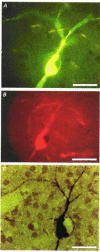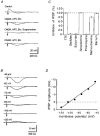Muscarinic IPSPs in rat striatal cholinergic interneurones
- PMID: 9705993
- PMCID: PMC2231046
- DOI: 10.1111/j.1469-7793.1998.421bk.x
Muscarinic IPSPs in rat striatal cholinergic interneurones
Abstract
1. Intracellular recordings were made from neurones in slice of rat striatum in vitro. 2. The forty-nine neurones studied were immunoreactive for choline acetyltransferase and had the electrophysiological characteristics typical of large aspiny interneurones. 3. Focal stimulation of the slice elicited a hyperpolarizing inhibitory postsynaptic potential in thirty-five neurones. This IPSP lasted 0.5-1 s and reversed polarity at a membrane potential which was dependent on the logarithm of the extracellular potassium concentration. 4. The IPSP was reversibly blocked by scopolamine and methoctramine, which has some selectivity for M2 subtype of muscarinic receptor. It was unaffected by 6-cyano-7-nitroquinoxaline-2,3-dione (10 microM), DL-2-amino-phosphonovaleric acid (30 microM) and bicuculline (30 microM). 5. Exogenous acetylcholine and muscarine also hyperpolarized the neurones, and this was blocked by methoctramine by not by pirenzepine, which is an M1 receptor-selective antagonist. 6. The findings demonstrate that muscarinic IPSPs occur in the central nervous system. The IPSP may mediate an 'autoinhibition' of striatal cholinergic neurone activity.
Figures



Similar articles
-
Short-term plasticity at inhibitory synapses in rat striatum and its effects on striatal output.J Neurophysiol. 2001 May;85(5):2088-99. doi: 10.1152/jn.2001.85.5.2088. J Neurophysiol. 2001. PMID: 11353025
-
Cholinergic excitation of GABAergic interneurons in the rat hippocampal slice.J Physiol. 1992 May;450:127-42. doi: 10.1113/jphysiol.1992.sp019119. J Physiol. 1992. PMID: 1359121 Free PMC article.
-
Identification of an ATP-sensitive potassium channel current in rat striatal cholinergic interneurones.J Physiol. 1998 Jul 15;510 ( Pt 2)(Pt 2):441-53. doi: 10.1111/j.1469-7793.1998.441bk.x. J Physiol. 1998. PMID: 9705995 Free PMC article.
-
Muscarinic receptor agonists and antagonists: effects on cardiovascular function.Handb Exp Pharmacol. 2012;(208):299-316. doi: 10.1007/978-3-642-23274-9_13. Handb Exp Pharmacol. 2012. PMID: 22222704 Review.
-
Striatal interneurones: chemical, physiological and morphological characterization.Trends Neurosci. 1995 Dec;18(12):527-35. doi: 10.1016/0166-2236(95)98374-8. Trends Neurosci. 1995. PMID: 8638293 Review.
Cited by
-
Spontaneous Synaptic Activation of Muscarinic Receptors by Striatal Cholinergic Neuron Firing.Neuron. 2016 Aug 3;91(3):574-86. doi: 10.1016/j.neuron.2016.06.021. Epub 2016 Jun 30. Neuron. 2016. PMID: 27373830 Free PMC article.
-
Burst generation mediated by cholinergic input in terminal nerve-gonadotrophin releasing hormone neurones of the goldfish.J Physiol. 2013 Nov 15;591(22):5509-23. doi: 10.1113/jphysiol.2013.258343. Epub 2013 Aug 19. J Physiol. 2013. PMID: 23959678 Free PMC article.
-
Activation of beta1-adrenoceptors excites striatal cholinergic interneurons through a cAMP-dependent, protein kinase-independent pathway.J Neurosci. 2003 Jun 15;23(12):5272-82. doi: 10.1523/JNEUROSCI.23-12-05272.2003. J Neurosci. 2003. PMID: 12832552 Free PMC article.
-
Recurrent inhibitory network among striatal cholinergic interneurons.J Neurosci. 2008 Aug 27;28(35):8682-90. doi: 10.1523/JNEUROSCI.2411-08.2008. J Neurosci. 2008. PMID: 18753369 Free PMC article.
-
Nucleus Accumbens Acetylcholine Receptors Modulate Dopamine and Motivation.Neuropsychopharmacology. 2016 Nov;41(12):2830-2838. doi: 10.1038/npp.2016.81. Epub 2016 May 31. Neuropsychopharmacology. 2016. PMID: 27240658 Free PMC article.
References
-
- Akins PT, Surmeier DJ, Kitai ST. Muscarinc modulation of a transient K+ conductance in rat neostriatal neurons. Nature. 1990;344:240–242. 10.1038/344240a0. - DOI - PubMed
-
- Calabresi P, Pisani A, Mercuri NB, Bernardi G. The corticostriatal projection: from synaptic plasticity to dysfunctions of the basal ganglia. Trends in Neurosciences. 1996;19:19–24. - PubMed
-
- Caulfield MP. Muscarinic receptors: characterization, coupling and function. Pharmacology and Therapeutics. 1993;58:319–379. - PubMed
Publication types
MeSH terms
Substances
LinkOut - more resources
Full Text Sources

